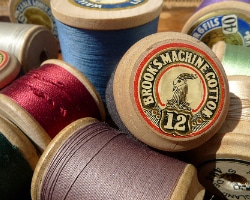
There's a deep and lasting satisfaction in sewing something. Whether you're making a skirt or hand stitching an ornament, when you finish a project, you have something that you made with your own two hands.
The surge in interest in sewing in recent years goes hand-in-hand with the upswing in popularity of handmade goods. Quilting alone is a huge industry in the United States. According to the 2006 Quilting In America report, quilters spent $3.3 billion on quilting materials, books, magazines, classes, equipment, and other quilting-related items. Then there are the sewers who make clothing and toys and accessories for their homes.
All the sewing we're doing can have a significant impact on the environment. Whether you're a dedicated sewer or a weekend dabbler, here are a few simple ways to make your creations a bit more eco-friendly.
Sew With Organic Cotton
Conventionally grown cotton is one of the most polluting crops, and it consumes a disproportionate amount of pesticides and insecticides. In India, home to one-third of all cotton producers, cotton occupies just 5 percent of farmland, but cotton-growing accounts for 54 percent of all pesticides used each year, according to the Environmental Justice Foundation. Aldicarb, the second most-used pesticide in cotton production, is a powerful neurotoxin—just one drop on the skin can kill a man.
By sewing with organic cottons, you can help support the organic cotton industry, which is growing every year, thanks in part to the efforts of major retailers and fabric designers who are expanding organic cotton product lines.
Save and Reuse Scraps
Most sewing projects produce a fair amount of usable scraps, and for a long time, those scraps were relegated to the trash. But a lot of sewers are growing aware of waste they produced and they're looking for ways to use their scraps, or at least save them from the garbage bin.
A few simple ways you can use your scraps are to cut them into small pieces so they can be used as filler in small stuffed toys, ornaments and even pillows. You could also use scraps to make quirky patchwork toys for kids, or even dresses for dolls. There are tons of tutorials available on websites and blogs that can provide all sorts of instruction and inspiration for using your scraps.
If you can't use your scraps, consider passing them along to someone who can. Donate them to a school so kids can use them for craft projects, or give them to a friend who's working on a scrappy project. If you have a blog, consider a give-away for your readers—you'd be surprised how many people would love to get their hands on your fabric scraps.
Use Upcycled Materials
Next time you need new fabric, forgo a trip to the fabric store and head to your local thrift store to score some great, inexpensive fabrics. From velvet dresses from the '80s to floral curtains to basic cotton shirts, you can find all sorts of fabrics at thrift stores. Don't forget to keep an eye out for clothing that features cool vintage buttons—a $5 shirt is a steal if it comes with buttons that will make your next sewing project pop.
Using secondhand clothing as a material helps reduces the waste that piles up in landfills, and it affords an opportunity to save fabulous materials that are sadly fashioned into outdated and unflattering styles. Many thift shops also benefit charities, so sourcing materials also does some extra good in the world.
Simply by choosing organic fabrics, reducing waste, and making the most of no-longer-loved clothing, you can indulge your love of sewing and reduce your environmental footprint. Talk about a win-win.










